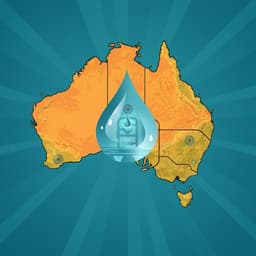
Environmental Studies and Forestry
Benefits, costs and enabling conditions to achieve ‘water for all’ in rural and remote Australia
A. Manero, W. Adamowicz, et al.
Australia faces a challenge in achieving universal access to safe drinking water by 2030, particularly for rural and remote communities. This research, conducted by Ana Manero, Wiktor Adamowicz, and others, estimates the substantial benefits of upgrading water services in these communities, highlighting the willingness to pay and necessary investment to ensure sustainable improvements.
~3 min • Beginner • English
Introduction
Sustainable Development Goal (SDG) target 6.1 aims for universal, equitable access to safe and affordable drinking water by 2030. Despite high coverage in most high-income countries, service and monitoring gaps persist, particularly between metropolitan and small, rural and remote (SRR) communities in countries such as Australia, the United States and Canada. In Australia, 395 SRR communities (under 10,000 residents) recorded exceedances against Australian Drinking Water Guidelines (ADWG) for health-based and aesthetic parameters in 2018–2019, and many more communities lack adequate monitoring. Elevated costs, monitoring and maintenance challenges, and capital-intensive infrastructure create barriers for SRR improvements, often requiring cross-subsidies. A key policy challenge is that beneficiaries in SRR areas do not necessarily bear the full costs, while taxpayers in urban centres fund public services. This study seeks to estimate: (1) Australians’ willingness to pay (WTP) for improving drinking water to ‘good-quality’ in SRR communities; (2) the capital and operating costs to achieve these improvements; and (3) the enabling conditions—particularly for Indigenous communities—to effectively deliver culturally appropriate, sustainable water services.
Literature Review
The paper situates its contribution within literature on drinking water inequities in high-income countries and non-market valuation of water quality improvements. Prior work documents persistent gaps in water service quality and monitoring in rural and remote communities in the Global North, including Australia, the US and Canada. The study draws on stated preference methods and guidance for mitigating hypothetical bias (e.g., consequentiality, certainty calibration, attribute non-attendance) and on evidence of altruism in public good valuation of water quality improvements. Comparative WTP findings from Canada, OECD countries, and low-income country contexts illustrate positive welfare gains from improved water quality and service delivery, with scope sensitivity and diminishing marginal utility commonly observed. The cost analysis references Urban National Performance Reports (NPRs) for utilities >10,000 connections and Commonwealth Grants Commission (CGC) cost disability factors to infer costs for SRR systems, acknowledging limited direct cost data for small systems in Australia.
Methodology
Benefits (WTP) estimation: The authors conducted a nationwide online stated preference survey (final n=3,523 adult Australian residents for taxation purposes; two binary choice tasks per respondent, total 7,046 observations) in August 2022, following multiple focus groups and pilot rounds. The survey presented a referendum-style vote on a proposed government program to improve SRR drinking water to ADWG ‘good-quality’ standards for populations known to have experienced substandard quality in 2018–2019 (260,000 people across 395 communities). Attributes varied across tasks included coverage level (25%, 50%, 100% of affected population) and an annual household tax increase for 10 years (AU$50, AU$200, AU$500, AU$1,000), with explicit earmarking and framing for consequentiality. Randomization ensured balance across combinations. Binary probit models estimated the probability of a Yes vote as a function of improvement level and tax bid, with nine model specifications; three focal models reported are: Model 1 (full sample); Model 2 (subsample perceiving payment consequentiality); Model 3 (adds exclusion of tax non-attendance and ex post certainty calibration, recoding uncertain Yes to No). Mean WTP and 95% CIs were computed parametrically (delta method), with non-parametric lower-bound checks. National aggregation applied household counts (9.48 million households in 2022) and conservative adjustments for survey non-participants (assumed zero WTP) and subsample proportions meeting consequentiality and tax-attendance criteria (yielding 6.05M, 4.04M, and 3.62M willing-to-pay households for Models 1–3, respectively). Socio-demographic covariates were analysed for heterogeneity in support.
Cost estimation: Given sparse small-system cost data, the study used Urban National Performance Report (NPR) panel data for utilities (>10,000 properties) to infer relationships between changes in capital and operating expenditures and changes in water quality complaints, with fixed effects and robust standard errors. Three complaint scenarios were modelled (no complaints, median, and 95th percentile complaints per capita) to estimate incremental capital and operating costs required to reduce complaints, scaled to small SRR communities (<10,000 residents). Commonwealth Grants Commission (CGC) cost disability factors (remoteness, population size, Indigenous communities) adjusted costs for SRR contexts. Equivalent annualized costs over a 10-year horizon were computed, and complementary state budget data (NSW and WA) informed cross-checks of per-community costs (including sewerage in some estimates). The analysis then compared aggregated benefits (WTP) to total costs across scenarios and models to assess net benefits, implied social rate of return, and referendum-style acceptance probabilities.
Enabling conditions review: The authors reviewed evidence and case studies (e.g., Torres Strait pilot) to identify enabling conditions for sustainable, culturally appropriate service delivery in SRR and Indigenous communities, emphasizing systems approaches, authentic engagement, training, and cross-agency coordination.
Key Findings
- Mean household WTP (per year for 10 years) to deliver ‘good-quality’ drinking water to all 395 non-compliant SRR communities ranges from AU$324 (Model 3) to AU$847 (Model 2). For total (100%) improvement, Model 1 yields AU$781, Model 2 AU$847, Model 3 AU$324.
- WTP declines with reduced coverage but less than proportionally (e.g., Model 1: AU$781 at 100% vs AU$662 at 50%, a 15% decrease).
- Aggregated annual benefits (assuming zero WTP for non-respondents) range from AU$1.17 billion yr−1 (Model 3) to AU$4.72 billion yr−1 (Model 1). Ten-year NPV (7% discount rate) ranges from AU$8.25 billion (Model 3) to AU$33.17 billion (Model 1). Alternative aggregation (across all households without non-response adjustment) yields higher totals (e.g., Model 1: AU$7.40 billion yr−1; 10-year PV AU$51.99 billion).
- Estimated incremental capital and operating costs to achieve ‘good-quality’ water across the 395 SRR communities: per-community average AU$0.51–3.28 million (depending on complaint reduction scenario). Total costs across all 395 communities: AU$0.20–1.30 billion.
- Preference heterogeneity: Gender (males more likely Yes in Models 2–3), occupation (primary caregivers, full-time and self-employed less likely Yes; students more likely No vs unemployed baseline), political orientation (Greens/Labor more likely Yes), personal financial concern (more likely No), and pro-environmental concerns (water availability, climate change; more likely Yes) are significant determinants in various models.
- Voting outcomes: Yes-vote shares ranged from 34% (25% improvement, AU$1,000 tax) to 86% (100% improvement, AU$50 tax) in the full sample; 15% to 74% in Model 3 subsample. Acceptance probabilities for a referendum-style vote exceed 50% across models even under the highest cost scenario; estimated probabilities of a Yes vote: 69% (Model 1), 71% (Model 2), 58% (Model 3).
- Economic viability: Aggregate benefits substantially exceed cost ranges across all models and scenarios, indicating a high positive social rate of return for achieving SDG 6.1-equivalent good-quality drinking water in SRR communities.
Discussion
The study directly addresses the policy question of whether there is sufficient public support and economic justification for investing in improved drinking water quality for Australia’s SRR communities. Empirical WTP estimates demonstrate strong societal support—including from households already enjoying good-quality water—for funding improvements via a dedicated household tax. Aggregated benefits substantially exceed the estimated program costs across multiple model specifications and cost scenarios, implying a high social rate of return and robust economic justification for public investment. Preference heterogeneity highlights distributional and political considerations, suggesting communication and policy design that account for financial concerns and emphasize public health and environmental co-benefits may enhance support. The findings also underscore that improvements should be embedded within enabling conditions—authentic engagement with Indigenous communities, culturally competent approaches, operator training, cross-agency coordination, and tailored, fit-for-purpose systems—to ensure sustainable outcomes. The work is globally relevant, indicating that investments to close rural-urban water quality gaps can yield high social returns in both Global North and South contexts.
Conclusion
This paper quantifies the nationwide benefits (WTP) and the capital and operating costs of delivering ADWG ‘good-quality’ drinking water to 395 SRR communities in Australia and outlines enabling conditions for sustainable, culturally appropriate implementation. Households are willing to pay AU$324–847 per year for 10 years, translating into aggregate benefits that markedly exceed total estimated costs (AU$0.20–1.30 billion), implying high net benefits and favorable acceptance probabilities for a referendum-style funding mechanism. The study provides a framework for prioritizing and investing in ‘water for all’ through rigorous benefit–cost comparison and attention to enabling conditions and systems approaches. Future work should expand analyses to communities with monitoring/reporting gaps and incorporate comprehensive benefit categories (e.g., avoided bottled water costs, productivity, health and well-being gains). Establishing a standardized national drinking water database, including costs and water quality outcomes, would improve decision-making and benefit–cost assessment.
Limitations
- Benefits and costs were not estimated for communities lacking monitoring or reporting, including over 500 SRR communities and many homelands/outstations; thus, aggregate estimates may understate national needs and benefits.
- The WTP survey, while nationally representative on key demographics, applied stated preference methods subject to hypothetical bias; mitigation steps (consequentiality, attribute non-attendance checks, certainty calibration) were applied but residual bias may remain.
- Some benefits for SRR residents (e.g., avoided avoidance costs, productivity, health and healthcare cost reductions) were not separately quantified beyond their inclusion in WTP.
- Limited publicly available cost data for small systems required inference from Urban NPR utility data and application of CGC cost disability factors; resulting estimates, while statistically supported, carry uncertainty relative to direct project-level costings.
Related Publications
Explore these studies to deepen your understanding of the subject.







